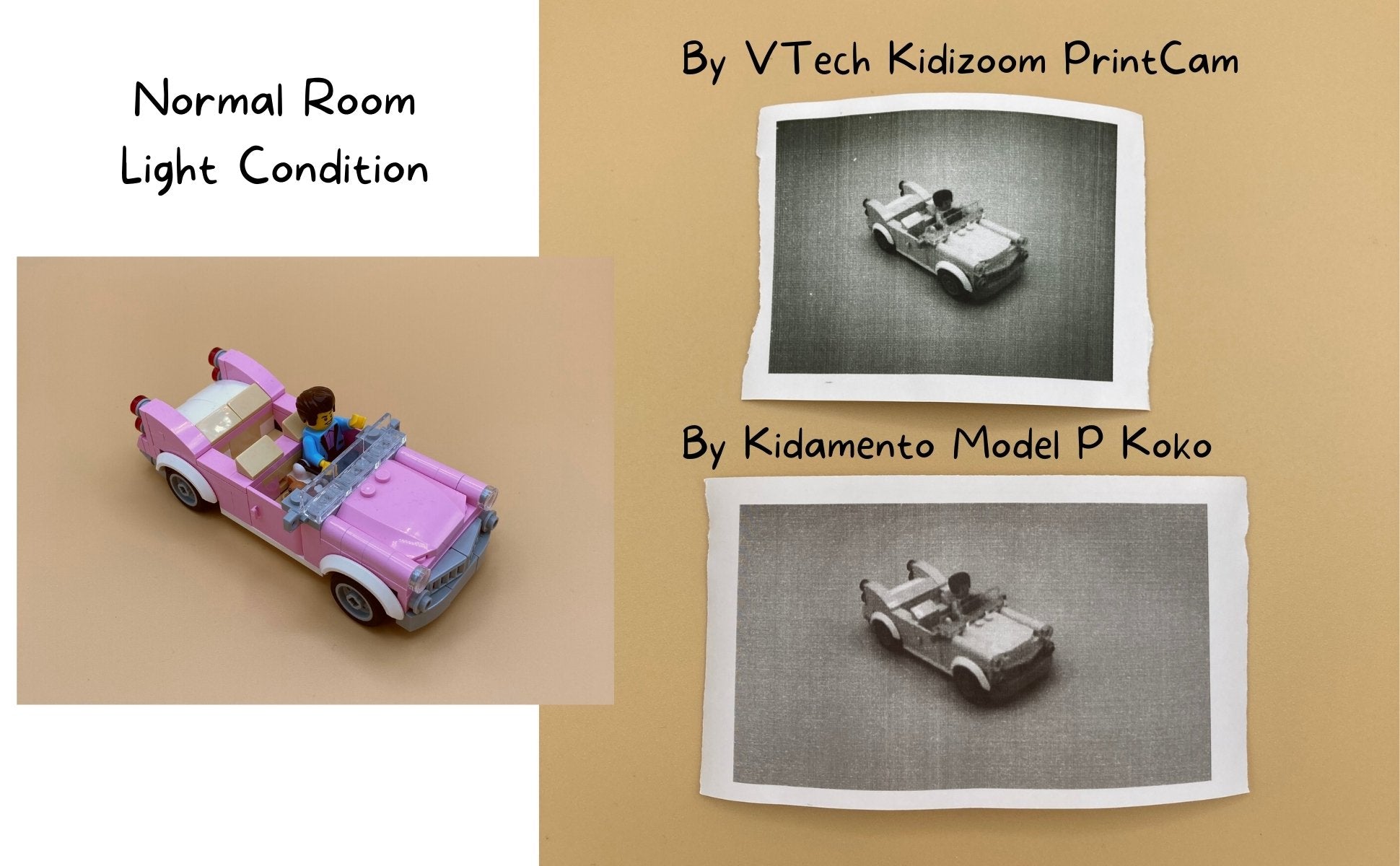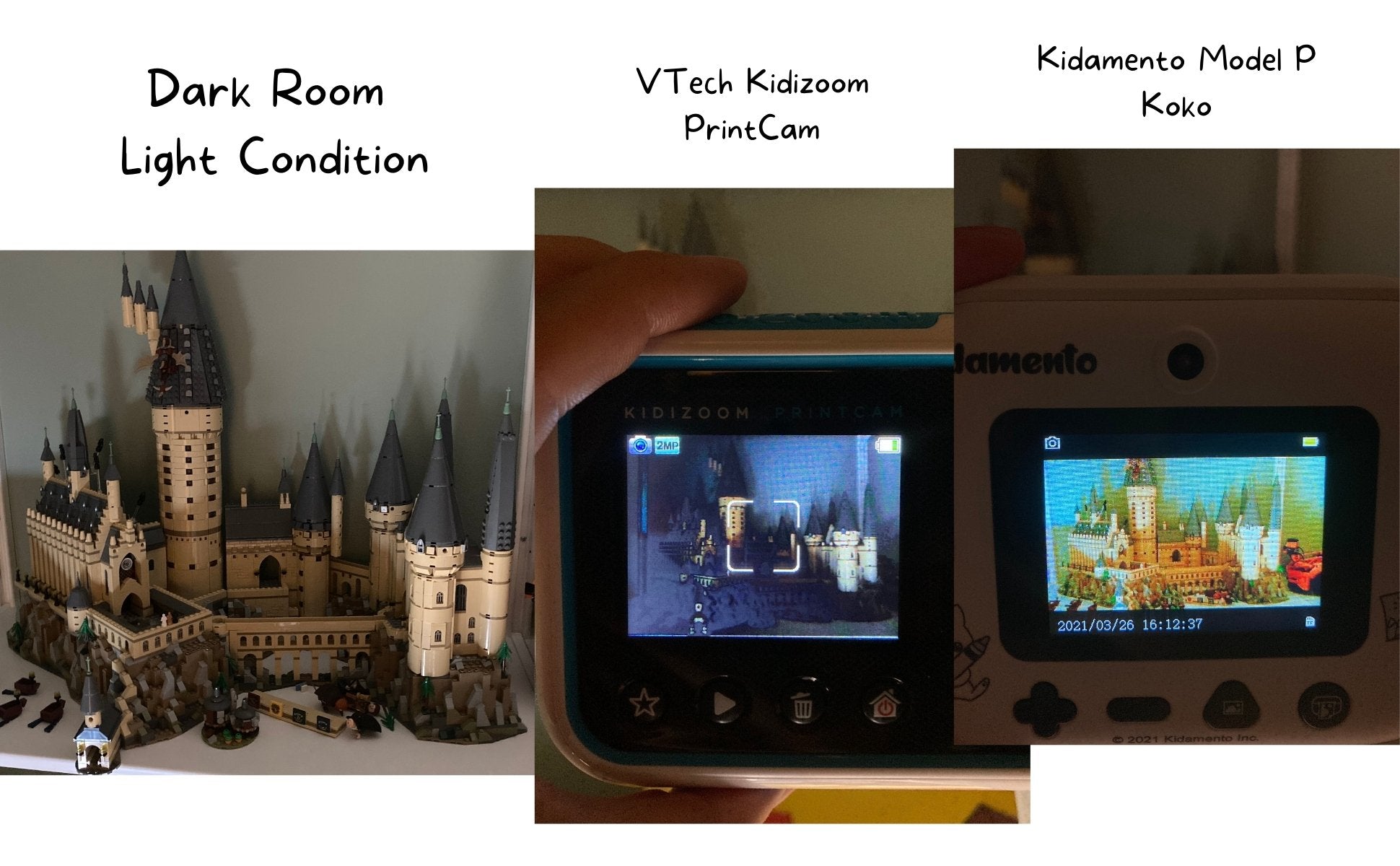When a company makes a product, you’d better believe they stand behind their product. But that doesn’t mean that we aren’t excited to try out similar toys and gadgets on the market. So, when we saw that VTech had released a new camera, we were like kids in a candy store eager to test it out.
Why the KidiZoom, you ask? Because it is their thermal instant print that our Model P Instant Print and KidiZoom Print Camera have in common. It is also what sets them apart from all other toy digital cameras on the market in Canada and the USA.
But would the VTech’s new KidiZoom prove to be better than our Model P we call Koko? With the following objective comparison and review, we were set to find out. Taking into seven different categories, let’s get into it. May the best camera win.
1. Packaging
We don’t know about you, but ever since having a child, the environment and health of our planet weigh heavily on our minds. We understand that how we package our goods goes a long way into helping reduce excess waste and keeping plastics out of our landfills and bodies of water.
As you can see in the picture below, the packaging of the KidiZoom is larger than that of our Koko. Not only is the packaging bigger, but most of the space is also taken by air. But is that extra space filled with bonus pieces? We’re afraid not.

So, how does that package compare to that of the Koko? As you can see, Koko’s packaging is smaller. That is because we strategically tightly pack everything inside so that it is more compact. Which one do you think our planet would choose?
We were also surprised that upon removal of the KidiZoom camera from its packaging that we needed to use a Phillips screwdriver. Picture it. You find a unique gift for your child, maybe it’s even for Christmas? And in the excitement of the moment, your child can’t even open it.

You keep promising your eager child that once everyone has opened their gifts and you find the right screwdriver, you will open it for them. But to make matters worse, later that day after you managed to get the camera out of the package now it comes time to put in the printer paper.

This my friends mean you must use yet another screwdriver. But it’s not the same screwdriver as before, this one requires a flathead screwdriver. If only there were a better way? Now, let’s compare it with the Koko camera.
Not only does the camera slide out of its packaging with ease, but it also doesn’t require a single tool to change the printing paper. Children can even do it themselves. After a quick hands-on demonstration from a parent, it takes less than ten seconds to swap a new roll of paper into the compartment.

2. The Design of the Camera
Next, we looked at the designs of each. While both cameras are roughly the same size, the weight of the Koko is lighter. Being light-weight is an important feature when being held by smaller hands. Both models, however, can be operated easily by an adult single-handily.
KidiZoom is ergonomically designed to fit into the two hands of the child holding onto it. But for the children who want to operate their camera easily with one hand while they set up their creations with the other will find this challenging.

What is interesting to note is that this KidiZoom model we have in hand appears to have an assembly issue. Where the KidiZoom logo is printed, the plastic part is not fully seated in the camera’s body. This can be seen in the image below. How many kids do you know won’t wonder why that is and try to remove it?

3. Camera Lens
The KidiZoom has one all-purpose lens; the Koko has two. One lens is for a regular shoot; the other is for selfies. With the KidiZoom the lens is flipped to the top position facing back when a child wants to switch to selfie-mode. The Koko requires that the child press a button to flip between the two lenses. Neither one stands out as overly complicated.
But let’s take a look at the photos below comparing the different lenses of each camera. While ordinary shooting with either will do a fine job, what if your child wants to shoot at night and needs night vision? Is there a difference between the two? Read on to number six on our list to find out.

4. Screen
In previous models of the KidiZoom series, we have always found the screens disappointing. They have a very narrow view angle and give off a lot of reflective light. This fatigues our eyes quite easily. But maybe this time it will be different.
As we turned the camera on and looked at the screen, we find our previous disappointment once again return. While looking at the screen straight on with a 90° angle isn’t a problem, if we move it to a 45° angle, we can barely see the screen. Even further at 10°, it becomes impossible to see anything.

Now for the Koko, which has an IPS screen – otherwise known as in-plane switching. This type of screen gives off the best viewing angles and true color pixels compared to other types of display panels. It also comes with eye-fatigue protection. This is critical to protect your children's eyes.
Looking at the photos below, each taken at the same angles we took with the KidiZoom above, you can see that the screen remains crisp and clear. Meaning when your child excitedly runs up to you to show you the picture they just took, the entire family can gather around and ooh and aww without having to do the head bobble looking for an angle that isn’t blinding them with the reflective light.

5. Thermal Instant Printing
Now here’s where we really got excited; this is what we are here for. We compared the core feature of these two cameras and what sets them apart from the rest.
Below are two pictures. The first picture on the left is taken by an iPhone to give you an idea of what the object looks like in real life. We used Lego® products because they have a detailed texture that we want the cameras to capture.
The second picture on the right contains two pictures printed by each camera; KidiZoom on the top and Koko on the bottom.

Each photo has been shot inside a lightbox. Each printed picture has different ratios, for example, Koko’s print is wider.
Now, to the average user, the KidiZoom photo comes off as having a darker background. As experts in the field, we can tell you that this is known as having a heavy vignette effect. You can see that the Koko does a better job of balancing the background with the forefront image. But for this purpose, both seem to capture the details well.
But what about more complicated objects? And what if they are captured under normal room light?

As you recall, the KidiZoom prints darker photos which means when the details are important, they get lost in the darkness. In comparison, Koko has a much sharper image, and the contrast is bang-on.

Another example. You can clearly see the bricks’ pattern on the picture from the Koko camera.

Once again, Koko keeps most of the essential details of the Lego® car in the above photo.

This is one of our favorite Lego® sets. We are so proud of Koko. Great job for capturing such a detailed and beautifully built castle.
6. Photography in a Dark Room
Recall how we showed you with pictures above the lenses on both cameras. Now let’s see how these two lenses handle taking a picture in the dark.

The one on the left is the iPhone with its night vision, a great photo. The middle is the KidiZoom, and as you can see, the castle on the screen is hard to make out. But for Koko, thanks to its sensitive camera sensor, seeing the castle on the screen is not a problem.

And remember how we talked about the screen view angle difference? Here is the comparison of the KidiZoom on the left and Koko on the right.
In this side-by-side comparison once again, the Koko’s screen stands out as if it were a sunny day, while the KidiZoom’s screen stays hidden in the dark.

But just for fun, we decided to do some instant print pictures in this dark room to compare.
Well, we could try to compare their quality, but as you can see in the pictures below it’s pretty pointless to do so with the KidiZoom.

7. Bonus Features
Lastly, let’s take a look at the bonus features. Compared to other KidiZoom models, we are delighted that the Print Cam finally has a built-in rechargeable battery. As always, the KidiZoom has built-in games, but we don’t bother. And we know our customers don’t bother either.
None of the Kidamento cameras have games, not in the past, not now, and not in the future.
Each camera does come with a way to support it. For the KidiZoom you will find a small lanyard that is meant to fit around an adult-sized wrist. The Koko comes with a wide and soft neck strap, making it more accessible to all who use it.
KidiZoom includes some well-designed frames and some creative tools. Koko likewise contains built-in frames but also comes with a large sticker sheet. These stickers let children make their camera unique from other kids. And while this may seem like a simple thing, parents with multiple children know that the same camera for each kid doesn’t fly in their house.
Koko has wireless capability. Not only can parents connect to their phones wirelessly, but this allows them to gain instant access to over 100 cute frames and stickers. So, when we say your children can make their cameras unique, we mean it.
And if your children are unsure where to start with their photos, Koko comes with a scavenger hunt photobook to further inspire their imagination.
More than a bonus, the Koko camera can also be turned into a powerful black and white wireless printer. Simplicity to make any parents’ life easier. Lastly, Koko comes with a 16GB MicroSD card, KidiZoom does not.
Final Thoughts
We looked at seven different categories, from the cameras’ appearance to their packaging, their screens to their thermal instant printing. In each category, we found that each time the KidiZoom seemed to do a fine job, but didn’t surpass our expectations. Even more, when it came to their thermal instant printing.
We believe that if you are going to advertise a particular feature about your camera, it should be the best. And while we believe you can’t go wrong in giving the gift of photography to any child, we do believe the type of camera you choose to give makes a difference. We know which one wins it for us, which one will win it for your child?
Click here to read more blogs from Kidamento.










